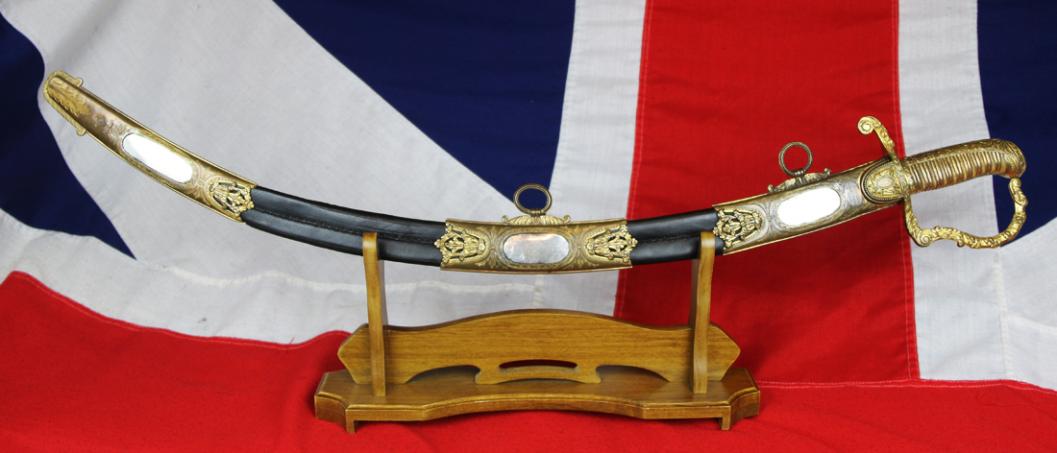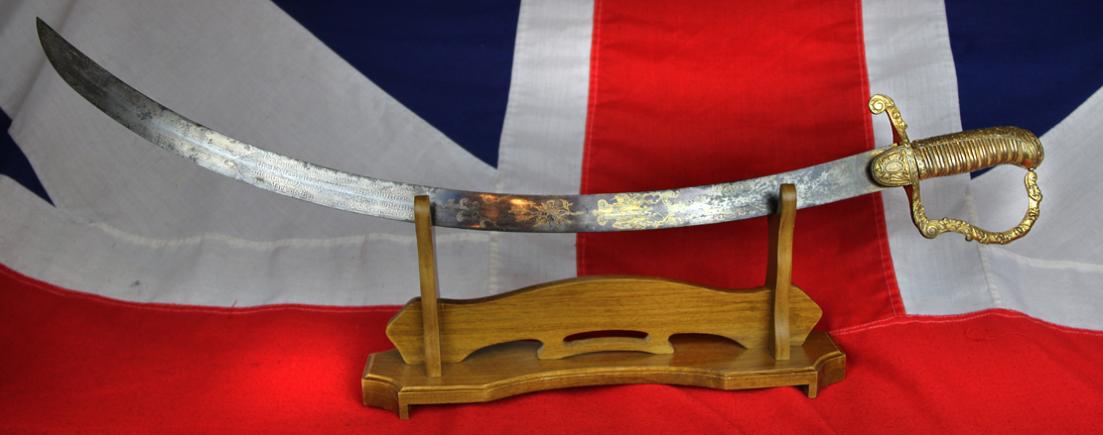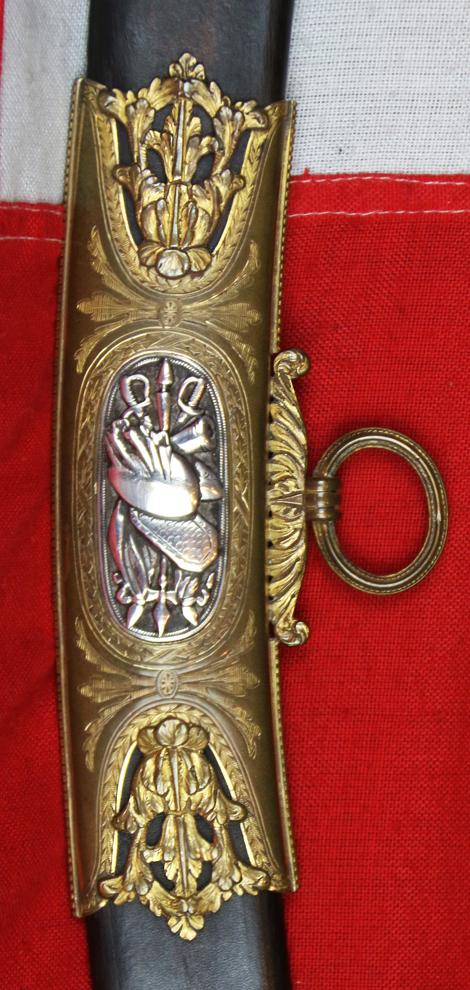Most Incredible & Finest Quality King George IIIrd Napoleonic Wars Scottish Presentation Sword, Presented In The Months Following the Battle of Trafalgar The Regiment of Midlothian Infantry, East Midlothian, By the Officer's & Men of The New Battle Co.
This is a magnificent ‘royal grade’ museum piece, a sublime quality presentation sword, made with the finest copper-gilt mounts, silver panels, and a stunning blue and gilt blade with deluxe engraving and etched presentation panel. A sword of the highest rank, commissioned to be hand made by Mr Phillip Rundell & Mr George Bridge, partners of their company of personal goldsmiths to King George IIIrd, and one of the worlds finest makers of objects of magnificence, including the British Crown Jewels, universally recognised as the finest, and most valuable by far, suite of royal regalia in the world.
Formerly in the world famous Smithsonian Collection in Washington, America, sold by them over 25 years ago to raise an urgent need of funds.
In the days it was commissioned it would have been made for the equivalent and likely same cost of the £100 Lloyds Patriotic Fund Presentation Swords, that were presented to the heroes of the Royal Navy, such as that fought at Trafalger etc. Bearing in mind the value of £100 in 1806 was a simply remarkable sum, for example only 6% of the families in Britain had a total income of £100 in an entire year in 1806, an equivalent today of around £80,000.
Presentation inscription motto etched onto the blade reads;
‘Into whose hand
this sword is put,
It’s hop’t will not
fear Buonaparte,
So draw me out
I shine so clear
and if I strike
my foes may fear”
This fabulous sword, was made by Philip Rundell and George Bridge whose company later made The British Imperial State Crown, the most famous and important royal crown of state ever made, and last used by her Majesty Queen Elizabeth II for her coronation in 1953. This wondrous sword was formerly from the Smithsonian Collection in Washington, and is remarkably similar to the most valuable and highest quality presentation British swords of the Napoleonic Wars, the Lloyds Patriotic Fund sabres, that today can fetch up to £220,000, considerably more than they were achieving 40 years ago when we sold a fine £100 pound Lloyds sword, and even 20 years ago when we sold our last Lloyds £100 pound sword. This sword's makers were King George IIIrds personal goldsmiths, and made the Irish Crown Jewels in 1830, and Queen Victoria's Imperial State Crown " expressly made for the solemnity of the Coronation" That was last used by Her Majesty Queen Elizabeth IInd for her coronation. This spectacular sword is inscribed that its bearer should fight Napoleon Bonaparte without fear, but his foes The French will fear its startling brightness and beauty. It has a sharply curved blade, decorated with stands of arms, a crowned GR cypher, the king's Royal arms, a figure of Britannia, and the motto see photo in the gallery and another further Scottish regimental presentation panel on the opposing side of the blade see photo. The dedication reads;
Presented by the New battle company of
The Eastern Regt. of Midlothian Volunteer
Infantry, to David Wight Esq, their Captain
as a Mark of their Regard and Esteem, 1806
It has a superbly detailed classically styled stirrup hilt decorated with acanthus scrolls, oak leaves and acorns, with the langets decorated with stands of arms, it has a copper gilt simulated wire and ribbon bound grip, contained in its ornately mounted silver and copper gilt leather scabbard, each mount finely engraved and decorated with acanthus leaf bouquets and featuring a central oval silver plaque decorated with stands of arms, the upper mount with maker's panel. This amazing sword was formerly in the collection of the Smithsonian in Washington, USA, bequeathed to them by a famed American collector of Napoleonic arms, which they sold for the benefit of the Smithsonian's funds over 25 years ago. Blade 75 cm approx. Maker marked by Philip Rundell and George Bridge of London. The firm was appointed as one of the goldsmiths and jewellers to the king in 1797 and Principal Royal Goldsmiths & Jewellers in 1804, and the firm held the Royal Warrant until 1843. They served four monarchs: George III, George IV, William IV and Victoria. After the Congress of Vienna (1814–1815), the firm prepared 22 snuff-boxes to a value of 1000 guineas each to be given as diplomatic gifts.
In 1830–1831, the firm created the Irish Crown Jewels from 394 precious stones taken from the English Crown Jewels of Queen Charlotte and the Order of the Bath star of her husband George III, and Queen Victoria's Imperial State Crown for her coronation. Despite the incredible success of the Battle of Trafalgar, and the routing of Napoleon’s French and Spanish fleet by Admiral Nelson, concern was still great amongst the people of Britain, in fact it was never greater, of the fear that Bonaparte would continue his efforts to confound and attempt to conquer Britain and its empire, and thus to create his own empire controlling all of Europe And Russia. Rundells quality of workmanship was so fine and renowned throughout the world that there are over 100 items by Rundells in the Royal collection alone.
This wonderful sword was obviously worn with pride by its recipient officer, thus the blade shows commensurate signs of light surface wear as to be expected.
We can, if required, commission a contemporary, bespoke glazed & framed display cabinet made by our local specialist artisan. Perfectly suitable for table or wall mounting. With several options of wood framing types, such as gilt, black or silver, also with coloured velvet backing options, and a suitably engraved brass plaque if required.
The scabbard has a blank silver panel on the inner throat mount that could have been presentation engraved but hasn't been
Code: 23375
36950.00 GBP










